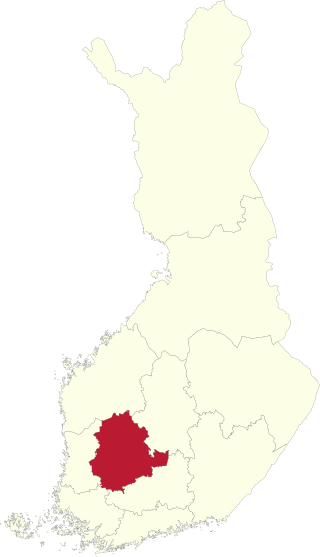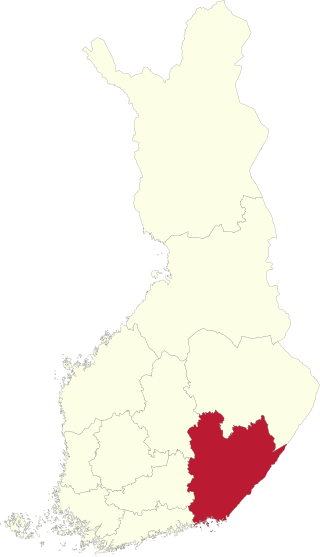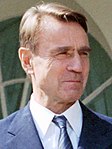
Paavo Matti Väyrynen is a Finnish politician who has served, among other things, as Minister of Foreign Affairs from 1977 to 1982, and again from 1983 to 1987 and from 1991 to 1993. He is a former member of the Finnish Parliament who has represented the Seven Star Movement, the Citizen's Party and Centre Party. He left the Centre Party in 2023.

Varsinais-Suomi is one of the 13 electoral districts of the Parliament of Finland, the national legislature of Finland. The district was established as Turku Province South in 1907 when the Diet of Finland was replaced by the Parliament of Finland. It was renamed Varsinais-Suomi in 1997. It is conterminous with the region of Southwest Finland. The district currently elects 17 of the 200 members of the Parliament of Finland using the open party-list proportional representation electoral system. At the 2023 parliamentary election it had 398,903 registered electors.

Helsinki is one of the 13 electoral districts of the Parliament of Finland, the national legislature of Finland. The district was established as Helsinki City in 1954 from parts of Uusimaa Province. It was renamed Helsinki in 1997. It is conterminous with the municipality of Helsinki. The district currently elects 23 of the 200 members of the Parliament of Finland using the open party-list proportional representation electoral system. At the 2023 parliamentary election it had 546,375 registered electors.

Central Finland is one of the 13 electoral districts of the Parliament of Finland, the national legislature of Finland. The district was established as Vaasa Province East in 1907 when the Diet of Finland was replaced by the Parliament of Finland. It was renamed Central Finland Province in 1960 and Central Finland in 1997. It is conterminous with the region of Central Finland. The district currently elects 10 of the 200 members of the Parliament of Finland using the open party-list proportional representation electoral system. At the 2023 parliamentary election it had 226,335 registered electors.

Oulu is one of the 13 electoral districts of the Parliament of Finland, the national legislature of Finland. The district was established as Oulu Province South in 1907 when the Diet of Finland was replaced by the Parliament of Finland. It was renamed Oulu Province in 1939 and Oulu in 1997. It is conterminous with the regions of Kainuu and North Ostrobothnia. The district currently elects 18 of the 200 members of the Parliament of Finland using the open party-list proportional representation electoral system. At the 2023 parliamentary election it had 393,643 registered electors.

Pirkanmaa is one of the 13 electoral districts of the Parliament of Finland, the national legislature of Finland. The district was established as Häme Province North in 1907 when the Diet of Finland was replaced by the Parliament of Finland. It was renamed Pirkanmaa in 1997. It is conterminous with the region of Pirkanmaa. The district currently elects 20 of the 200 members of the Parliament of Finland using the open party-list proportional representation electoral system. At the 2023 parliamentary election it had 437,155 registered electors.

Satakunta is one of the 13 electoral districts of the Parliament of Finland, the national legislature of Finland. The district was established as Turku Province North in 1907 when the Diet of Finland was replaced by the Parliament of Finland. It was renamed Satakunta in 1997. It is conterminous with the region of Satakunta. The district currently elects eight of the 200 members of the Parliament of Finland using the open party-list proportional representation electoral system. At the 2023 parliamentary election it had 176,653 registered electors.

Häme is one of the 13 electoral districts of the Parliament of Finland, the national legislature of Finland. The district was established as Häme Province South in 1907 when the Diet of Finland was replaced by the Parliament of Finland. It was renamed Häme in 1997. It is conterminous with the regions of Kanta-Häme and Päijät-Häme. The district currently elects 14 of the 200 members of the Parliament of Finland using the open party-list proportional representation electoral system. At the 2023 parliamentary election it had 310,047 registered electors.

Uusimaa is one of the 13 electoral districts of the Parliament of Finland, the national legislature of Finland. The district was established as Uusimaa Province in 1907 when the Diet of Finland was replaced by the Parliament of Finland. It was renamed Uusimaa in 1997. It is conterminous with the region of Uusimaa but excludes the municipality of Helsinki which has its own electoral district. The district currently elects 37 of the 200 members of the Parliament of Finland using the open party-list proportional representation electoral system. At the 2023 parliamentary election it had 801,205 registered electors.

Vaasa is one of the 13 electoral districts of the Parliament of Finland, the national legislature of Finland. The district was established in 1960 by the merger of Vaasa Province North and Vaasa Province South districts. It is conterminous with the regions of Central Ostrobothnia, Ostrobothnia and South Ostrobothnia. The district currently elects 16 of the 200 members of the Parliament of Finland using the open party-list proportional representation electoral system. At the 2023 parliamentary election it had 365,027 registered electors.
Parliamentary elections were held in Finland on 18 and 19 March 1979.
Parliamentary elections were held in Finland on 20 and 21 March 1983. The elections were widely regarded as a "protest election" because, contrary to expectations, the major parties with the exception of the Social Democratic Party (SDP) performed poorly; the Liberal People's Party (LKP) lost all its seats in the Eduskunta, while the Finnish Rural Party (SMP) more than doubled its seat tally and the Greens won seats for the first time. The SMP's success was credited, at least in part, to voter distaste for some mainstream parties because of political scandals; no significant policy differences emerged in the election campaign. The SDP won 57 seats, the best performance by a party since World War II.
Parliamentary elections were held in Finland on 15 and 16 March 1987.

Parliamentary elections were held in Finland on 17 March 1991, the first time a Finnish parliamentary election had been held on a single day. For the first time since 1962 the Social Democratic Party was displaced as the largest party in the Eduskunta, with the Centre Party winning 55 seats and forming the first centre-right, non-social democratic government since 1964, with Esko Aho as Prime Minister.

Presidential elections were held in Finland on 16 January 1994, with a second round on 6 February. It was the first time the President had been solely and directly elected by a popular vote. Martti Ahtisaari defeated Elisabeth Rehn in the second round.

Two-stage presidential elections were held in Finland in January 1982. The public elected presidential electors to an electoral college on 17 and 18 January. They in turn elected the president. The result was a victory for Mauno Koivisto, the first member of the Social Democratic Party to be elevated to the country's highest post, and his election meant the full integration of Social Democrats into Finnish public life and an end to the postwar dominance of the Centre Party.

Presidential elections were held in Finland in January and February 2012. The first round took place on 22 January 2012 with advance voting between 11 and 17 January. Since no candidate received a majority of the vote, a second round was held on 5 February, with advance voting between 25 and 31 January. Sauli Niinistö was elected the President of Finland for a term from 1 March 2012 until 1 March 2018.
Two-stage presidential elections were held in Finland in 1968. On 15 and 16 January the public elected presidential electors to an electoral college. They in turn elected the President. The result was a victory for Urho Kekkonen, who won on the first ballot. The turnout for the popular vote was 70%.

Southeast Finland is one of the 13 electoral districts of the Parliament of Finland, the national legislature of Finland. The district was established in 2013 by the merger of Kymi and South Savo districts. It is conterminous with the regions of Kymenlaakso, South Karelia and South Savo. The district currently elects 15 of the 200 members of the Parliament of Finland using the open party-list proportional representation electoral system. At the 2023 parliamentary election it had 353,468 registered electors.

Savo-Karelia is one of the 13 electoral districts of the Parliament of Finland, the national legislature of Finland. The district was established in 2013 by the merger of North Karelia and North Savo districts. It is conterminous with the regions of North Karelia and North Savo. The district currently elects 15 of the 200 members of the Parliament of Finland using the open party-list proportional representation electoral system. At the 2023 parliamentary election it had 343,887 registered electors.






















